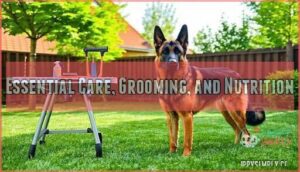This site is supported by our readers. We may earn a commission, at no cost to you, if you purchase through links.

These Belgian shepherds aren’t your typical family pet who’ll be content with a daily walk around the block. They’re wired to work, bred for stamina, and built to think three steps ahead of you.
If you’re considering bringing one into your life, you need to understand what you’re really signing up for—because respect and commitment aren’t optional with this breed.
Table Of Contents
Key Takeaways
- Belgian Malinois demand 1-2 hours of intense daily exercise combined with mental stimulation—without this non-negotiable commitment, you’ll face destructive behaviors and anxiety that stem from their bred-in work drive.
- This breed ranks as the most intelligent among tested dogs (35 out of 39 points in cognitive assessments) with genetic variants making them exceptionally trainable, but that same intelligence means they’ll outsmart inexperienced owners who lack structure.
- They’re not suitable for novice owners, apartment living, or typical family situations—97% of experienced handlers emphasize these dogs need active homes with fenced yards, established routines, and owners who can match their intensity level.
- Health screening is critical since they’re prone to hip/elbow dysplasia (2-7% prevalence), epilepsy (9.5% of Belgian Shepherds), and progressive retinal atrophy, making genetic testing and regular veterinary monitoring essential before breeding or purchasing.
Belgian Malinois Breed Overview
The Belgian Malinois isn’t your average family pet—this breed demands respect, understanding, and commitment from day one. Before you decide if a Malinois is right for you, you need to know what makes them tick.
Let’s cover the basics first: their history, physical traits, and what sets them apart from German Shepherds.
Origin and History
The Belgian Malinois traces its Belgian roots to Mechelen in the late 1800s, where breeders like Adrien Janssens prioritized working ability over looks. Foundation dogs such as Vos I established the Malinois heritage, leading to early recognition when the breed standard was published in 1892.
Several key developments shaped this exceptional herding breed:
- Foundation dogs like Salmo and Tomy cemented bloodlines that defined the breed’s legendary work ethic
- Police forces adopted Malinois by 1911 in U.S. cities, proving their value beyond Belgian farms
- World Wars devastated populations, yet dedicated breeders revived the breed through focused efforts
- AKC recognition in 1959 officially distinguished Belgian Malinois breed characteristics from other shepherds
The breed’s strong work ethic standards have made them highly valued as working dogs.
Size, Appearance, and Lifespan
Once you know the Malinois’s heritage, you’ll want to understand what these dogs actually look like and how long they usually stick around. Males stand 24-26 inches tall and weigh 60-80 pounds, while females measure 22-24 inches and weigh 40-60 pounds. Their short, smooth double coat comes in rich fawn to mahogany shades with black masks.
With proper Belgian Malinois health and care, you’re looking at 10-14 years together—plenty of time to build that unbreakable bond this dog breed’s known for.
Temperament and Personality Traits
Beyond their striking looks and impressive stats, what really sets this breed apart is the powerhouse personality packed into that athletic frame. Belgian Malinois characteristics include a confident nature and exceptional canine intelligence that demands respect.
Their high prey drive and herding instinct mean they’re always “on”—watching, thinking, calculating. You’ll find intense loyalty traits here, with social bonds forming strongest with one person.
Their emotional intelligence helps them read situations fast, though aggressive tendencies can surface without proper channeling of that natural dog temperament.
Differences From German Shepherds
People often confuse these two breeds, but look closer and you’ll spot clear distinctions. Size differences show German Shepherds averaging 10% heavier, while Malinois present a square, leaner profile. Bite strength favors Shepherds at 238 psi versus 195 psi, though both excel in guarding ability.
The real breed comparison winner? Exercise needs. Belgian Malinois demand 3–4 hours daily—noticeably more than German Shepherds—making Belgian Malinois training and high energy management the greatest test for owners. Understanding the working dog traits is essential for effective training and care.
Key Characteristics and Behavior
Before you commit to a Belgian Malinois, you need to know what drives them. Their behavior isn’t random—it’s the result of generations bred specifically for work, not companionship.
Here’s what makes them tick.
Intelligence and Trainability
The Belgian Malinois ranks as the most intelligent breed among dogs tested, scoring 35 out of 39 points in thorough Cognitive Abilities assessments. This breed’s learning capacity isn’t just impressive—it’s backed by genetics. Specific gene variants make them exceptionally easy to train, which explains their dominance in police work and detection.
Your Malinois excels at Problem Solving and spatial reasoning, outperforming even Border Collies in Trainability Tests. With proper Belgian Malinois training strategies, you’ll utilize this Intelligence to build an obedient, focused companion.
Energy Levels and Activity Needs
If you’ve ever watched a Malinois in action, you know this isn’t a dog that does well lounging on the couch—this breed demands serious daily commitment to physical and mental activity that goes far beyond a casual stroll around the block.
Your Belgian Malinois needs at least one to two hours of vigorous aerobic training daily. Without adequate mental stimulation and high-energy exercise like running, hiking, or intensive play sessions, you’ll face destructive behaviors and anxiety. Think of their exercise needs as non-negotiable fuel that powers their outstanding performance.
Protective Instincts and Loyalty
Loyalty in a Malinois isn’t just affection—it’s an intense, almost singular devotion that makes them bond fiercely with their primary handler while staying perpetually alert to potential threats.
This protective behavior stems from their pack leader mentality and high prey drive, making them outstanding guard dogs. Their defense mechanisms kick in fast, so you’ll need loyalty training early to channel these instincts appropriately and guarantee family bonds remain balanced with their natural dog behavior.
Interaction With Children and Other Pets
Think of a Malinois around kids like a sports car in a school zone—powerful, but needing careful management. These aren’t typical kid-friendly family dogs—they’re better for experienced households with older children who respect boundaries. Without supervision and child safety protocols, their energy creates risks.
Early pet socialization before 12 weeks cuts herding nips by 72%, making family integration smoother. In multi-pet homes, introduce them gradually; 68% show dominance initially.
They’re seldom stranger-friendly or quiet—expect a tendency to bark when protecting territory.
Health Considerations and Common Issues
Belgian Malinois are hardy dogs, but they carry a few genetic conditions worth knowing about before you commit to one.
Knowing what to watch for and how to screen for these issues can save you heartbreak and help your dog live a longer, healthier life. Let’s look at the most common health concerns and what you can do to stay ahead of them.
Being aware of these issues and catching them early can spare you a lot of pain—and give your Malinois the best shot at a long, healthy life.
Here are the main health problems to know about and how to stay on top of them.
Hip and Elbow Dysplasia
Joint health problems like hip dysplasia and elbow dysplasia affect between 2% and 7% of Belgian Malinois, depending on breeding lines. Hip dysplasia remains the more common health issue, while elbow screening shows this breed ranks lower-risk than many large working dogs.
You’ll reduce health concerns markedly by choosing puppies from health-tested parents and maintaining ideal body weight during growth. Canine orthopedics experts recommend radiographic screening and controlled exercise as key dysplasia prevention strategies.
Progressive Retinal Atrophy and Eye Health
Progressive Retinal Atrophy strikes Belgian Malinois without warning, slowly stealing their vision as the retina degenerates over months or years. This inherited eye disease has no cure, but responsible breeders use genetic testing to screen breeding stock. You’ll want annual eye exams to catch cataracts and other vision problems early.
Key eye health priorities:
- Schedule yearly veterinary ophthalmology exams to monitor retinal health and detect early signs of blindness
- Request genetic testing results from breeders before purchasing to prevent progressive retinal atrophy
- Watch for night blindness symptoms—your dog bumping into objects in dim lighting signals vision loss
- Maintain consistent home layouts so visually impaired dogs navigate safely using memory and spatial awareness
Other Hereditary Health Concerns
Beyond vision loss, your Malinois faces several genetic vulnerabilities you can’t ignore. Epilepsy affects roughly 9.5% of Belgian Shepherds, with seizures sometimes triggered by stress or overexcitement—epilepsy management requires veterinary neurological care. Hypothyroidism ranks moderately high in this breed, causing weight gain and skin problems that respond well to hypothyroidism treatment through hormone supplementation. Cardiac risks include congenital defects and enlarged heart conditions, particularly in working-line dogs under constant physical demands.
Autoimmune disorders like thyroiditis and skin conditions hit middle-aged Malinois hardest. You’ll need genetic screening before breeding to identify carriers of ataxia (KCNJ10 gene mutation) and other hereditary health issues beyond standard hip dysplasia, elbow dysplasia, progressive retinal atrophy, and thyroid disease.
| Health Issue | Key Management Strategy |
|---|---|
| Epilepsy (9.5% prevalence) | Stress reduction, medication, neurological monitoring |
| Hypothyroidism | Synthetic hormone therapy, regular blood testing |
| Cardiac abnormalities | Screening for working dogs, activity modification |
| Autoimmune skin disorders | Immune support, dermatological assessment |
| Kidney/urinary stones | Periodic urinalysis, dietary adjustments |
Preventative Care and Veterinary Screening
Regular screening lets you stay ahead of the health issues Malinois are prone to. Veterinary health screening should follow these protocols:
- Vaccine schedules and annual health checks starting at 8 weeks, with booster shots protecting against distemper and parvovirus
- Screening tests for hip/elbow dysplasia at 2 years, plus yearly eye exams for progressive retinal atrophy
- Parasite control and dental care every 6 months to prevent health problems before they escalate
Essential Care, Grooming, and Nutrition
Your Belgian Malinois needs more than exercise and training to thrive—daily care of their coat and diet matters just as much.
Their double coat sheds constantly, and their active lifestyle burns through calories fast—getting these basics right is what separates good ownership from great.
Here’s what you need to know about grooming essentials and proper nutrition.
Coat Care and Shedding
Your Belgian Malinois sports a short, weather-resistant double coat that sheds consistently throughout the year, with a noticeable uptick during spring and fall. Weekly brushing helps control loose hair and maintains coat health.
To keep that coat in top shape, you’ll want:
| Grooming Task | Frequency | Tools Needed |
|---|---|---|
| Brushing | Weekly (daily during heavy shedding) | Slicker brush, undercoat rake |
| Bathing | As needed (every 2-3 months) | Dog-specific shampoo |
| Shedding control | Year-round | Regular brushing routine |
This minimal grooming approach is effective because the coat’s texture naturally repels dirt and water, making Belgian Malinois grooming needs more straightforward compared to other breeds.
Nail, Ear, and Dental Hygiene
Brushing keeps your Malinois looking good, but don’t skip the less glamorous stuff—nail trims, ear checks, and dental care prevent painful infections and bigger health issues down the line.
Trim nails every month or two—you’ll hear clicking on floors when they’re too long. Check ears weekly for redness or odor, and brush teeth daily to maintain gum health and prevent oral hygiene issues that could lead to serious health complications down the road.
Diet, Feeding Guidelines, and Nutritional Needs
A high-performance dog diet starts with the right fuel. Belgian Malinois need 25–30% protein and 15–20% fat to support their intense activity levels and lean muscle mass. Feed adults twice daily, adjusting portions based on caloric intake—usually 2,000–3,000 calories for working dogs.
Here’s what matters most:
- Choose AAFCO-certified puppy food or adult dog food with real meat listed first
- Match feeding schedules to life stage: puppies eat three to four times daily
- Add nutrient supplements like glucosamine for joint support if needed
Keep treats under 10% of total calories and monitor macronutrient balance closely to prevent weight gain or digestive issues.
Skin Care and Parasite Prevention
Healthy skin isn’t just about looks—it’s your Malinois’ first line of defense against infections, allergies, and the relentless army of fleas, ticks, and heartworm that target active dogs.
Check regularly for skin allergies like hot spots or irritation, especially after outdoor work. Use vet-approved parasite medicine year-round for flea control and tick prevention.
Your dog’s minimal grooming needs don’t mean skipping these health checks—coat health depends on it.
Training, Exercise, and Owner Suitability
A Belgian Malinois isn’t a casual choice. They’re intense, demanding dogs that require real dedication—both in training and daily exercise.
Before you commit, you need an honest picture of what life with one actually entails and whether you can realistically handle it.
So what does it actually take to keep a Malinois happy, healthy, and well-behaved?
Training Requirements and Socialization
Think of training a Belgian Malinois like sculpting marble—you’re not adding anything new, but shaping what’s already there into something remarkable.
Focus your training on three essentials:
Your training priorities should include:
- Obedience training with complex commands to channel their intelligence
- Puppy training classes that introduce social learning with other dogs
- Daily mental stimulation through varied exercises to prevent boredom
Consistent dog training and dog socialization aren’t optional—they’re survival skills for life with this breed.
Exercise Routines and Mental Stimulation
A tired Malinois isn’t just a well-behaved dog—it’s the difference between a focused companion and a whirlwind of destruction in your living room.
Plan for one to two hours of high-intensity training daily—aerobic exercise like running or biking paired with mental stimulation through puzzle toys or scent work.
Without meeting these exercise needs, your Belgian Malinois’ activity level will overwhelm even the most patient owner.
Suitable Activities and Dog Sports
Put that relentless energy to work in agility courses, tracking, or protection sports—your Malinois thrives when there’s a real job to do. Best activities for their intense drive:
Channel that relentless energy into agility courses, tracking work, or protection sports—your Malinois will thrive when given a job that matches their drive. Top choices for Belgian Malinois activity level include:
- Agility training for speed and precision
- Herding competitions to tap into natural instincts
- Flyball for explosive high-energy exercises
- Schutzhund combining obedience and protection
- Nose work providing intense mental stimulation
These canine sports satisfy your dog’s exercise needs while channeling that legendary work ethic.
Ideal Owners and Living Environments
You’re not ready for a Malinois if you’re a novice dog owner or planning apartment living without serious commitment—97% of experienced handlers warn this breed demands expertise.
These dogs excel in active homes with fenced yards, established family dynamics, and owners who embrace high activity levels daily.
They’re moderately kid-friendly and dog-friendly with early socialization, but don’t expect them to be stranger-friendly without consistent training and structure throughout their lives.
Pros and Cons of Belgian Malinois Ownership
Owning a Belgian Malinois isn’t for everyone—but if you can manage the intensity, the rewards run deeper than most breeds will ever offer. You’ll gain unparalleled loyalty, elite trainability, and a partner who thrives on challenge.
However, expect a significant time commitment, high prey drive management, considerable cost considerations, and a lifestyle impact that demands space requirements and family dynamics centered around this dog’s needs.
Frequently Asked Questions (FAQs)
What are Belgian Malinois adoption and rescue options?
Sometimes the hardest dogs to place are the easiest to love. Check breed-specific rescue groups and shelters for Belgian Malinois needing homes—they often support adopters through the process and offer foster care options.
How much does a Belgian Malinois puppy cost?
Belgian Malinois puppy costs vary widely depending on breeder reputation and lineage. You’ll generally pay between $1,000 and $3,500 from reputable Belgian Malinois breeders, while adoption fees range from $50 to $
Can Belgian Malinois adapt to cold weather climates?
While their short coats offer less insulation than fluffier breeds, Belgian Malinois tolerate cold weather reasonably well thanks to their high energy level and double-layered coat.
However, proper winter care is necessary during extreme frost to prevent hypothermia risk.
What are common behavioral problems in Belgian Malinois?
Without proper outlets, Malinois develop destructive behavior like chewing furniture or digging.
Their high energy and herding instinct can lead to anxiety issues, biting problems, and aggression management concerns.
Early socialization challenges and consistent dog training prevent these dog behavior issues in Belgian Malinois.
How do Belgian Malinois perform as family companions?
They can be excellent family dogs for the right household, but they’re not kid-friendly or stranger-friendly by default.
Family integration depends on early socialization, strong training, and meeting their companion needs—including intense exercise and clear household roles that channel their working drive.
Conclusion
If you’re drawn to the Belgian Malinois, prepare yourself—this isn’t a decision you make lightly, it’s a lifestyle you commit to. These dogs don’t do halfway; they demand structure, purpose, and an owner who matches their intensity.
A Belgian Malinois isn’t a casual choice—it’s a lifestyle commitment demanding structure, purpose, and an owner who matches their intensity
When you get it right, though, you’ll find a partner who’s loyal beyond measure, exceptionally intelligent in ways that surprise you daily, and capable of thriving in roles most breeds can’t touch. The Belgian Malinois isn’t for everyone, but for the right handler, they’re unparalleled.
- https://www.nature.com/articles/s41598-022-26991-5
- https://pangovet.com/?utm_source=dogster&utm_medium=article&utm_campaign=dog_behavior_training
- https://petkeen.com/how-to-get-therapy-dog-certification/
- https://www.secretservice.gov/about/faq/kids
- https://www.malinoisclub.com/abmc/about-malinois/history/














